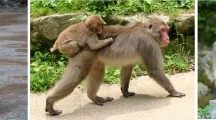Abstract
In search of the relevant difference between mother rearing and surrogate rearing with respect to the emergence of neophobic behavior in macaques, we tested the hypothesis that mobility of surrogate mothers prevents the development of neophobic behavior in cynomolgus macaques. The experimental group consisted of ten surrogate-reared subjects which during their first year got rides on surrogate mothers moving through the cage. The control group consisted of nine subjects reared with immobile surrogate mothers. Between the age of 7 and 27 months the reactions to two different novel objects were tested. First exposure to one object occurred at 6 months of age and to the other object at 20 months. The kind of object and the age of first exposure made no difference. Contrary to our expectations mobility of surrogates did not affect the incidence of neophobia: most subjects in both groups persistently avoided the objects. This finding seems to support Hofer's hypothesis that the mother acts as a regulator of the infant's behavior and physiology.
Similar content being viewed by others
References
Anderws, M. W.;Rosenblum, L. A. 1991. Attachment in monkey infants raised in variable- and low-demand environment.Child Develop., 62: 686–693.
Baldwin, J. D.;Baldwin, J. I. 1977. The role of learning phenomena in the ontogeny of exploration and play. In:Primate Biosocial Development,Chevalier-Skolnikoff,S.;Poirrier,F. E. (eds.), Garland Publ., New York, pp. 343–406.
Bowlby, J. 1988.A Secure Base. Basic Books, New York.
Bronson, G. W. 1968. The development of fear in man and other animals.Child Develop., 39: 409–431.
Duijghuisen, J. A. H.;Timmermans, P. J. A.;Vochteloo, J. D.;Vossen, J. M. H. 1992. Mobile surrogate mothers and the development of exploratory behaviour and radius of action in infant long-tailed macaques (Macaca fascicularis).Develop. Psychobiol., 25: 441–459.
Harlow, H. F.;Harlow, M. K. 1965. The affectional systems. In:Behavior of Nonhuman Primates, Vol. 2,Schrier,A. M.;Harlow,H. F.;Stollnitz,F. (eds.), Academic Press, New York, pp. 287–333.
Hofer, M. A. 1987. Early social relationships: a psychobiologist's view.Child Develop., 58: 633–647.
King, D. L. 1966. A review and interpretation of some aspects of the infant-mother relationship in mammals and birds.Psychol. Bull., 65: 143–155.
Kraemer, G. W. 1995. Significance of social attachment in primate infants: the infant-caregiver relationship and volition. In:Motherhood in Human and Nonhuman Primates,Pryce,C. R.;Martin,R. D.;Skuse,D. (eds.), Karger, Basel, pp. 152–161.
Mason, W. A. 1979. Maternal attributes and primate cognitive development. In:Human Ethology: Claims and Limits of a New Discipline,von Cranach,M.;Foppa,K.;Lepenies,W.;Ploog,D. (eds.), Cambridge Univ. Press. Cambridge, pp. 437–456.
Mason, W. A.;Berkson, G. 1975. Effects of maternal mobility on the development of rocking and other behaviors in rhesus monkeys: a study with artificial mothers.Develop. Psychobiol., 8: 197–211.
Mason, W. A.;Capitanio, J. P. 1988. Formation and expression of filial attachment in rhesus monkeys raised with living and inanimate mother substitutes.Develop. Psychobiol., 21: 401–430.
McNally, R. J. 1987. Preparedness and phobias: a review.Psychol. Bull., 101: 283–303.
Montgomery, K. C. 1955. The relation between fear induced by novel stimulation and exploratory behavior.J. Comp. Phys. Psychol., 48: 245–269.
Röder, E. L. 1990. Rearing condition and the acquisition of phobic behaviour in monkeys. Ph.D. diss., Univ. of Nijmegen, Nijmegen.
Röder, E. L.;Timmermans, P. J. A.;Vossen, J. M. H. 1989a. Effects of rearing and exposure condition upon the acquisition of phobic behaviour in cynomolgus monkeys (Macaca fascicularis).Behav. Res. Ther., 27: 221–231.
Röder, E. L.;Timmermans, P. J. A.;Vossen, J. M. H. 1989b. The role of modeling in prevention and extinction of phobic behaviour in cynomolgus monkeys (Macaca fascicularis).Behav. Res. Ther., 27: 637–645.
Rosenblum, L. A.;Pauly, G. S. 1984. The effects of varying environmental demands on maternal and infant behavior.Child Develop., 55: 305–314.
Russell, P. A. 1973. Relationships between exploratory behaviour and fear: a review.Brit. J. Psychol., 64: 417–433.
Schneider, M. L.;Suomi, S. J. 1992. Neurobehavioral assessment in rhesus monkey neonates (Macaca mulatta): developmental changes, behavioral stability, and early experience.Inf. Behav. Develop., 15: 155–177.
Timmermans, P. J. A.;Röder, E. L.;Hunting, P. 1986. The effect of absence of the mother on the acquisition of phobic behaviour in cynomolgus monkeys (Macaca fascicularis).Behav. Res. Ther., 24: 67–72.
Timmermans, P. J. A.;Röder, E. L.;Kemps, A. M. L. J. 1988. Rearing cynomolgus monkeys (Macaca fascicularis) on surrogate mothers with bottle-feeding.Lab. Anim., 22: 229–234.
Vochteloo, J. D.;Timmermans, P. J. A.;Duijghuisen, J. A. H.;Vossen, J. H. M. 1993. Effects of reducing the mother's radius of action on the development of mother-infant relationships in long-tailed macaques.Anim. Behav., 45: 603–612.
Vochteloo, J. D.;Timmermans, P. J. A.;Duijghuisen, J. A. H.;Vossen, J. M. H. 1995. The range of action of the mother and the avoidance of big novel objects in long-tailed macaques.Int. J. Primatol., 16: 277–293.
Vochteloo, J. D.;Timmermans, P. J. A.;Duijghuisen, J. A. H.;Vossen, J. M. H. 1996. The development of range of action in infant cynomolgus monkeys (Macaca fascicularis) reared by restrained mothers.Primates, 37: 167–173.
Author information
Authors and Affiliations
About this article
Cite this article
Timmermans, P.J.A., Vochteloo, J.D. & Vossen, J.M.H. Mobility of surrogate mothers and persistent neophobia in cynomolgus monkeys (Macaca fascicularis). Primates 38, 139–148 (1997). https://doi.org/10.1007/BF02382004
Received:
Accepted:
Issue Date:
DOI: https://doi.org/10.1007/BF02382004




